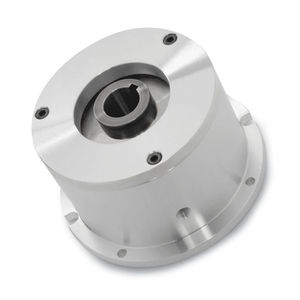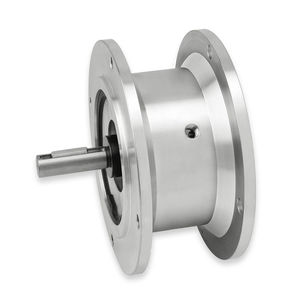
- Power Transmission - Mechanical components
- Mechanical Transmission
- Multiple-disc brake
- Mach III Clutch, Inc.
Pneumatic clamping brake STH Seriesmultiple-discrelease springadjustable

Add to favorites
Compare this product
Characteristics
- Type
- multiple-disc
- Operation
- release spring, pneumatic clamping
- Other characteristics
- adjustable, flange-mounted, bi-directional, through-bore, energize-to-engage, for shafts
- Torque
Min.: 8.333 ft.lb
Max.: 806.08 ft.lb
Description
Flange Mounted Friction Brakes For Stopping and Holding
Function: Stopping, Holding (Cycling Applications)
Drive Arrangement: Machine Frame or Bracket to Shaft
Operation
- Air pressure compresses drive and friction discs to produce torque.
- Torque is linear in response to the air pressure applied.
- Release springs provide positive disengagement when air is exhausted.
Mounting
- The brake flange bolts to a machine frame or other fixture, the shaft inserts into the bore and is fixed with a customer supplied key.
- Can also be mounted mid-shaft with the flange connected to a bracket.
- Air engaged friction brakes are designed for horizontal mounting. If vertical mounting is required, consult engineering.
Applications
- Air engaged friction brakes are suitable for stopping, holding and cycling applications.
- Maximum RPM varies by model and is listed on the PDF detail sheet (see table below). Consult engineering if the intended application exceeds the listed maximum RPM.
Design Features
- Air engaged brakes are made-to-order with any bore size up to the maximum shown for easy installation.
- Drilled and slotted flange allows for variable installation arrangements.
- Low coefficient friction lining versions are available for applications requiring slip or a narrower torque range. Contact engineering for details.
Catalogs
No catalogs are available for this product.
See all of Mach III Clutch, Inc.‘s catalogsRelated Searches
- Friction brake
- Spring brake
- Friction clutch
- Overload clutch
- Safety brake
- Pneumatic brake
- Spring activated brake
- Spring clutch
- Mechanical overload clutch
- Pneumatic clutch
- Failsafe brake
- Friction slip clutch
- Motor brake
- Multiple-disc clutch
- Safety torque limiter
- Adjustable brake
- Multiple-disc brake
- Combined clutch-brake unit
- Friction combined clutch-brake unit
- Clutch for heavy-duty applications
*Prices are pre-tax. They exclude delivery charges and customs duties and do not include additional charges for installation or activation options. Prices are indicative only and may vary by country, with changes to the cost of raw materials and exchange rates.




